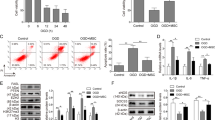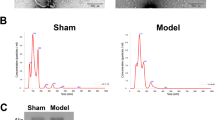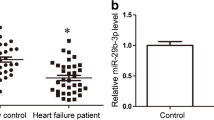Abstract
Recent studies have indicated a protective role of physiological autophagy in ischemic heart disease. However, the underlying mechanisms of autophagy regulation after ischemia are poorly understood. Exosomes are nano-sized vesicles released from cells that play critical roles in mediating cell-to-cell communication through the transfer of microRNAs. In this study, we observed that miR-30a was highly enriched in exosomes from the serum of acute myocardial infarction (AMI) patients in vivo and culture medium of cardiomyocytes after hypoxic stimulation in vitro. We also found that hypoxia inducible factor (HIF)-1α regulates miR-30a, which efficiently transferred via exosomes between cardiomyocytes after hypoxia. Inhibition of miR-30a or release of exosomes increased the expression of the core autophagy regulators beclin-1, Atg12, and LC3II/LC3I, which contributed to maintaining the autophagic response in cardiomyocytes after hypoxia. Taken together, the present study showed that exosomes from hypoxic cardiomyocytes regulate autophagy by transferring miR-30a in a paracrine manner, which revealed a new pathway of autophagy regulation that might comprise a promising strategy to treat ischemic heart disease.
Key messages
-
miR-30a is highly enriched in exosomes from the serum of AMI patients.
-
Hypoxia induces miR-30a upregulation and enrichment into exosomes.
-
MiR-30a is efficiently transferred via exosomes between hypoxic cardiomyocytes.
-
Inhibition of exosome release contributes to maintaining of autophagy after hypoxia.
-
Inhibition of miR-30a augments autophagy after hypoxia.







Similar content being viewed by others
References
Kanamori H, Takemura G, Goto K et al (2011) The role of autophagy emerging in postinfarction cardiac remodelling. Cardiovasc Res 91:330–339
Shintani T, Klionsky DJ (2004) Autophagy in health and disease: a double-edged sword. Science 306:990–995
Kanamori H, Takemura G, Goto K et al (2011) Autophagy limits acute myocardial infarction induced by permanent coronary artery occlusion. Am J Physiol Heart Circ Physiol 300:H2261–2271
Zhu H, Wu H, Li B et al (2009) Regulation of autophagy by a beclin 1-targeted microRNA, miR-30a, in cancer cells. Autophagy 5:816–823
Korkmaz G, le Sage C, Tekirdag KA et al (2012) miR-376b controls starvation and mTOR inhibition-related autophagy by targeting ATG4C and BECN1. Autophagy 8:165–176
Ucar A, Gupta SK, Fiedler J et al (2012) The miRNA-212/132 family regulates both cardiac hypertrophy and cardiomyocyte autophagy. Nat Commun 3:1078
Long G, Wang F, Duan Q et al (2012) Circulating miR-30a, miR-195 and let-7b associated with acute myocardial infarction. PLoS One 7:e50926
Skog J, Würdinger T, van Rijn S et al (2008) Glioblastoma microvesicles transport RNA and proteins that promote tumour growth and provide diagnostic biomarkers. Nat Cell Biol 10:1470–1476
Creemers EE, Tijsen AJ, Pinto YM (2012) Circulating microRNAs: novel biomarkers and extracellular communicators in cardiovascular disease? Circ Res 110:483–495
Thygesen K, Alpert JS, Jaffe AS et al (2012) Third universal definition of myocardial infarction. J Am Coll Cardiol 60:1581–1598
Dubovsky JA, Chappell DL, Harrington BK et al (2013) Lymphocyte cytosolic protein 1 is a chronic lymphocytic leukemia membrane-associated antigen critical to niche homing. Blood 122:3308–3316
Duisters RF, Tijsen AJ, Schroen B et al (2009) miR-133 and miR-30 regulate connective tissue growth factor: implications for a role of microRNAs in myocardial matrix remodeling. Circ Res 104:170–178
Pan W, Zhong Y, Cheng C et al (2013) MiR-30-regulated autophagy mediates angiotensin II-induced myocardial hypertrophy. PLoS One 8:e53950
Wang P, Zhang N, Liang J et al (2015) Micro-RNA-30a regulates ischemia-induced cell death by targeting heat shock protein HSPA5 in primary cultured cortical neurons and mouse brain after stroke. J Neurosci Res. doi:10.1002/jnr.23637
Mitchell PS, Parkin RK, Kroh EM et al (2008) Circulating microRNAs as stable blood-based markers for cancer detection. Proc Natl Acad Sci U S A 105:10513–10518
Mittelbrunn M, Sánchez-Madrid F (2012) Intercellular communication: diverse structures for exchange of genetic information. Nat Rev Mol Cell Biol 13:328–335
Vickers KC, Palmisano BT, Shoucri BM et al (2011) MicroRNAs are transported in plasma and delivered to recipient cells by high-density lipoproteins. Nat Cell Biol 13:423–433
Simons M, Raposo G (2009) Exosomes-vesicular carriers for intercellular communication. Curr Opin Cell Biol 21:575–581
Théry C, Amigorena S, Raposo G et al (2006) Isolation and characterization of exosomes from cell culture supernatants and biological fluids. Curr Protoc Cell Biol. doi:10.1002/0471143030
Peinado H, Aleckovic M, Lavotshkin S (2012) Melanoma exosomes educate bone marrow progenitor cells toward a prometastatic phenotype through MET. Nat Med 18:883–891
Kahlert C, Melo SA, Protopopov A et al (2014) Identification of double-stranded genomic DNA spanning all chromosomes with mutated KRAS and p53 DNA in the serum exosomes of patients with pancreatic cancer. J Biol Chem 289:3869–3875
Waldenström A, Gennebäck N, Hellman U et al (2012) Cardiomyocyte microvesicles contain DNA/RNA and convey biological messages to target cells. PLoS One 7:e34653
Herve JC, Derangeon M (2013) Gap-junction-mediated cell-to-cell communication. Cell Tissue Res 352:21–31
Singer SJ (1992) Intercellular communication and cell-cell adhesion. Science 255:1671–1677
Imagawa W, Pedchenko VK, Helber J et al (2002) Hormone/growth factor interactions mediating epithelial/stromal communication in mammary gland development and carcinogenesis. J Steroid Biochem Mol Biol 80:213–230
Chen WX, Zhong SL, Ji MH et al (2014) MicroRNAs delivered by extracellular vesicles: an emerging resistance mechanism for breast cancer. Tumour Biol 35:2883–2892
Valadi H, Ekstrom K, Bossios A et al (2007) Exosome mediated transfer of mRNAs and microRNAs is a novel mechanism of genetic exchange between cells. Nat Cell Biol 9:654–659
Zhang X, Wang X, Zhu H et al (2012) Hsp20 functions as a novel cardiokine in promoting angiogenesis via activation of VEGFR2. PLoS ONE 7:e32765
Malik ZA, Kott KS, Poe AJ et al (2013) Cardiac myocyte exosomes: stability, HSP60, and proteomics. Am J Physiol Heart Circ Physiol 304:H954–965
Raposo G, Stoorvogel W (2013) Extracellular vesicles: exosomes, microvesicles, and friends. J Cell Biol 200:373–383
Thery C, Ostrowski M, Segura E (2009) Membrane vesicles as conveyors of immune responses. Nat Rev Immunol 9:581–593
Klionsky DJ, Emr SD (2000) Autophagy as a regulated pathway of cellular degradation. Science 290:1717–1721
Nakatogawa H, Suzuki K, Kamada Y et al (2009) Dynamics and diversity in autophagy mechanisms: lessons from yeast. Nat Rev Mol Cell Biol 10:458–467
Yang Z, Klionsky DJ (2010) Mammalian autophagy: core molecular machinery and signaling regulation. Curr Opin Cell Biol 22:124–131
Kang R, Zeh HJ, Lotze MT et al (2011) The Beclin 1 network regulates autophagy and apoptosis. Cell Death Differ 18:571–580
Qu X, Yu J, Bhagat G et al (2003) Promotion of tumorigenesis by heterozygous disruption of the beclin 1 autophagy gene. J Clin Invest 112:1809–1820
Yue Z, Jin SK, Yang CW et al (2003) Beclin 1, an autophagy gene essential for early embryonic development, is a haploinsufficient tumor suppressor. Proc Natl Acad Sci U S A 100:15077–15082
Xiao J, Zhu X, He B et al (2011) MiR-204 regulates cardiomyocyte autophagy induced by ischemia-reperfusion through LC3-II. J Biomed Sci. doi:10.1186/1423-0127-18-35
Yu Y, Yang L, Zhao M et al (2012) Targeting microRNA-30a-mediated autophagy enhances imatinib activity against human chronic myeloid leukemia cells. Leukemia 26:1752–1760
Maiuri MC, Zalckvar E, Kimchi A et al (2007) Self-eating and self-killing: crosstalk between autophagy and apoptosis. Nat Rev Mol Cell Biol 8:741–752
Nakai A, Yamaguchi O, Takeda T et al (2007) The role of autophagy in myocytes in the basal state and in response to hemodynamic stress. Nat Med 13:619–624
Author information
Authors and Affiliations
Corresponding authors
Ethics declarations
Conflict of interest
The authors declare that they have no competing interests.
Funding information
This work was supported by the National Natural Science Foundation of China (81300179).
Additional information
Yan Yang, Yingying Li and Xiao Chen contributed equally to this work.
Electronic supplementary material
Below is the link to the electronic supplementary material.
ESM 1
(PDF 316 kb)
Rights and permissions
About this article
Cite this article
Yang, Y., Li, Y., Chen, X. et al. Exosomal transfer of miR-30a between cardiomyocytes regulates autophagy after hypoxia. J Mol Med 94, 711–724 (2016). https://doi.org/10.1007/s00109-016-1387-2
Received:
Revised:
Accepted:
Published:
Issue Date:
DOI: https://doi.org/10.1007/s00109-016-1387-2




